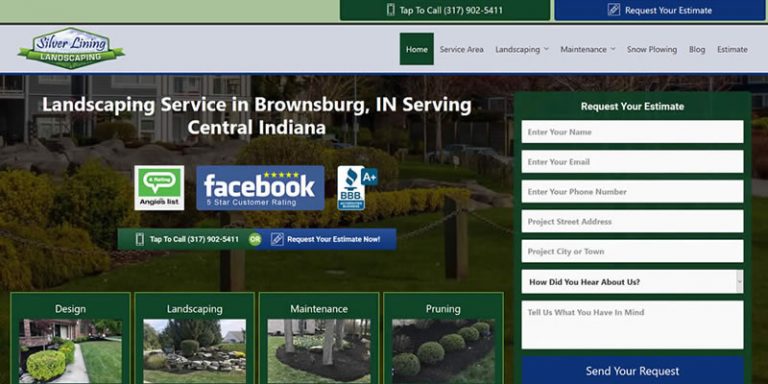10 Mistakes Contractors Make With Their Website & How To Fix Them
Do you have a website for your construction or contracting company? Does your website attract new potential clients or does it just sit there collecting digital dust? Having a website for your construction company isn’t really an option anymore, it’s a must-have marketing tool. With great websites being so effective at attracting new local clients for a business it’s almost unbelievable how many contractor websites are still poorly built and riddled with mistakes.
If you make just one of the mistakes we’ve listed below you’re losing revenue potential. If you’re making all of them then I can guarantee your website is one of those collecting digital dust. Fear not, we can help you get things back on track. The following article is going to discuss 10 of the most common mistakes construction and trades contractors are making with their websites.
The Top 10 Mistakes Contractors Are Making With Their Websites Right Now
#1. Your Website Isn’t Mobile Friendly.
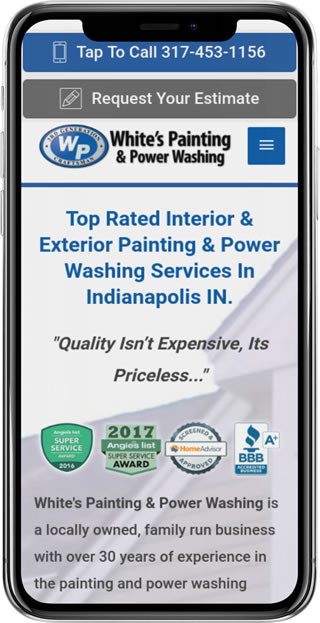
If you’re a construction or specialty trade contractor who’s had a website for several years it’s quite likely you haven’t touched the website in a long time. Older and outdated contractor websites are usually horribly outdated. This causes problems for the new wave of web traffic that is accessing your website using a mobile device.
If your website isn’t mobile friendly and responsive, then it’s probably offering your mobile visitors a pretty poor user experience. And websites that offer a poor user experience don’t get very good results because Google doesn’t want to rank them, and users don’t even want to use them anyway.
For those wondering what “responsive website” means, a responsive website is one that can automatically resize and reshape itself for the specific user’s device. Whether they’re on a desktop, a laptop, a tablet, an Android, or an iPhone, a responsive website is fast loading, more appealing, and easier for your visitors to use.
How Do You Fix It?
If you’re hiring a web developer to build your website, make sure the site is going to be responsive. If you have an older website get ready for some bad news… It’s really not cost-effective to optimize an older or outdated website for responsiveness. In most cases, it’s more cost effective to rebuild an old website.
#2. Poorly Written Meta Title Tags.
We’re going to get a little geeky here but don’t stop reading because this is one of the most common (and very easy to fix) mistakes we see on a contractors or tradepersons website. Especially if they built the website on their own or hired an inexperienced web developer. Poorly or incorrectly written meta title tags hurt your search engine rankings and they’ll actually steer people away from your website.
For those wondering, your title tag (or meta title tag) is simply the title of your web page. It displays in the browser bar when someone is visiting that particular page on your website.

This is also what shows up in search engine results pages describing what your website (or webpage) is about. It’s also the first indicator to search engine bots as to what your content might be about.

There are two title tag mistakes that we see most often on contractors websites:
A. Home pages with titles like “Home” or Services pages with a title like “Services”. Neither of these title tags would send strong signals to Google to describe what your company is about and, more importantly, where you provide your services. Your title tags should always contain your specific service or business type and your geographic area.
For example: “Home Remodeling Contractor in Seattle, Washington.”
B: Title Tags that are just the company name, like “Steve’s Construction Company.” While this title mentions you’re a construction company it doesn’t specific where you operate. The best title tags for a local contracting company should include their Service and their Service Area.
For example: “Plumber Serving Seattle, Washington.”
How Do You Fix It?
If you’ve hired a web developer and they’ve messed up your title tags, this isn’t a good sign. Title tags are like SEO basics 101 and if they couldn’t get this right there is an extremely high likelihood they have made many more mistakes, regardless, ask them to fix it for you. If you’ve built the website on your own and you’ve done your title tags wrong (more than likely you’ve just left them as the defaults) don’t panic, just hop into your website backoffice and edit the “Meta Title” or “Title Tag” field for each of your websites pages.
3. Your Website Doesn’t Have Enough Pages.
This is probably one of the most misunderstood website strategies and one area where many construction and trades contractors are suffering. When we talk to a contractor about building them a new website, most of the time, they just want something “simple”. They want a simple 5 page website (usually because they think it will be cheaper – and it will) but the problem is that a rinky dink little 5 page website doesn’t really give Google enough information about your company or what you specialize in.
As a general contractor, remodeling contractor, landscape contractor, plumber, or electrician you can break down your services into many different areas. For example, as a general contractor you might build home additions, shops and garages, and remodel kitchens. As a landscaper you might build new patios, retaining walls, install lawns, and provide maintenance. As a plumber you might provide emergency repairs, hot water tank replacements, offer camera inspections, and more.
What most contractors will do is build out a single page of their website and call it their “services” page. On this page they’ll list all the services they do.
- Service #1
- Service #2
- Service #3
- Service #4
This is a BIG mistake! As a contractor offering many different services why on earth would you try and list them all on one single page of your website? Yes, it saves time because it’s easy, yes it’s cheaper if you’ve hired someone to build it because they’ll spend less time. But, it’s a digital marketing mistake that can really hamper your results because it’s preventing your website from being found!
For example, if you’re a home remodeling contractor, you might want to have individual pages for the specific types of projects you complete, such as kitchen remodeling, bathroom remodeling, basement finishing, etc. By creating these targeted “landing” pages you’re going to be serving content that your visitor is actually searching for.
If you have a “Basement Finishing” page on your website and a web searcher in your area is searching “basement finishing contractors near me” there is a much higher chance of them finding your website because you have content that matches their search query.
How Do You Fix It?
When contractors are wondering how many pages their website should be the best strategy is to create individual pages on your website for every service that you want to offer. This certainly takes more time because someone will have to write all the content and organize the pages, but it’s a much more effective way to appear more frequently in search results and for the specific services you offer. Most of the contractor websites we build end up being between 20-50 pages in size depending on the specific type of contractor we’re working with.
If your website is less than 5 pages or less, or doesn’t break down your individual services then it’s time to hire a web developer to build this out for you or you need to take the time to create these pages on your own. When you’re dealing with contracts that could be worth thousands of dollars just imagine what you’ve cost your business in lost opportunities already if you’re not targeting visitors in this way. It’s time to change it!
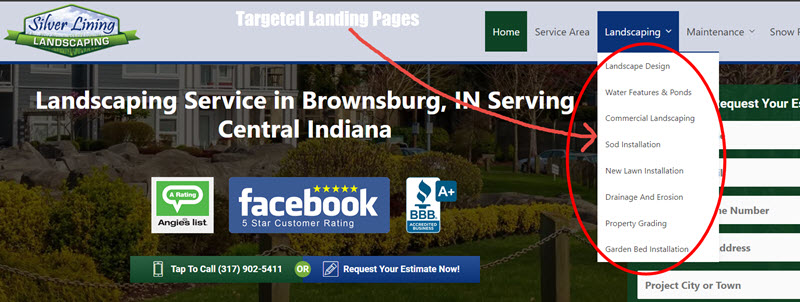
#4. Your Website Has Poor-Quality Photos Of Your Work
Most contractors provide a very visual service. If you want to attract high quality clients from your website then your website must display compelling photos that showcase your best work. If you’re working on very large projects, don’t even hesitate to hire a professional photographer to take some photos for you—it’s well worth the money and can dramatically improve the visuals on your website.
Strong visuals of the work you do help build your credibility and make your company appear more trustworthy/transparent. It also lets potential customers know you take a great deal of pride in your work. Don’t just create a “photo gallery” page on your website, load a few photos, and call it a day. You should spend the time to properly organize your photos by the specific project or project type.
By organizing your photo galleries in such a way, you create even more relevance on your landing pages. If a browser looking for “kitchen remodeling contractor” comes to your website and lands on your kitchen remodeling page, they will see a selection of kitchen remodeling photos from other projects you’ve completed. They’ll see these photos without having to click onto another page titled “photo gallery” as all of your kitchen remodeling photos will be right there for them to view on the page they landed on.
Making sure your content is relevant provides a much better user experience and will keep visitors on your website longer.
How Do You Fix It?
Start taking good quality photos of your projects. 5-10 really good photos from each project is enough for your web developer to work with. Before and after photos are also very powerful if you’re in a visual trade, they really give your visitors a reason to choose you.
What If My Trade Isn’t Very Visual?
Some contractors like plumbers and electricians, don’t have as many sexy photo opportunities as other contractors. Taking photos of a repaired sink or a new breaker panel aren’t very dramatic and they don’t keep a visitors attention for very long. That doesn’t mean you shouldn’t be taking photos though! I would just concentrate on taking a different kind of photo. Take photos of yourself working on a customers problem in your company shirts or with a company hat. These are called “branded photos” and they work like gangbusters to legitimize your company and they come off as much more professional than stock photos of some random plumber.
#5. Your Website Loads To Slow
Slow loading websites kill conversions. One major downside to an older websites or websites that are built on inferior platforms (often by lazy web developers) is that they can be incredibly slow. With so many of your visitors on mobile devices today, it’s critical that your website loads very quickly.
This can be challenging for a contractor or trades person, especially if you have a great collection of photos, as the photos must be optimized for fast loading speeds.
For help with this, use the Google PageSpeed Insights tool (developers.google.com/speed/pagespeed/insights/) to check your website speed and get suggestions on making it faster. These changes will usually be somewhat technical in nature, so you may want to ask your web developer to help you implement them.
How Do You Fix It?
This isn’t such a simple answer as there are various reasons your website could be slow. Is it built on an inferior piece of software? Are you using a bloated and clunky page builder? Do you have too many photos that aren’t optimized? Do you just have a really slow web host? The Google PageSpeed Insights tool as mentioned above can help get you on the right track.
#6. Your Website Doesn’t Have Google Analytics Or Search Console Setup
Most contractors have absolutely no idea how many visitors their website receives, what pages are the most popular, where visitors are coming from, what devices visitors are using, etc. Google Analytics is a free tool that can quickly be implemented on any website, and it helps provide you and your web developer with important metrics to help learn when it’s time to make improvements and squeeze more results out of your online marketing.
It’s free to sign up (analytics.google.com/analytics/web/), and it only takes about 5 minutes to get started.
#7. Contact Forms Lack the Necessary Details
Many contractor websites have basic contact forms—if they have one at all. Your contact form should be detailed and ask for the information you actually need to be able to help a customer. Instead of merely asking for a name, email and phone number, ask your potential prospects for more details.
Consider including contact form fields like “What is your project street address?” “What city are you located in?” or “Tell us about your project.” If your prospect is serious, they will usually explain what they need from you.
Anyone truly interested will not be turned off by being asked for these details. And as a business owner or salesperson, you’ll be armed with critical information when you follow up with that project lead, which will also save you time.
#8. It Does Not Implement Schema Markup (Microdata)
Schema markup, or “microdata,” is something that few web developers are adding into their websites, but it’s a very important piece to the puzzle. Microdata are small snippets of code that send detailed information to search engines about your business.
This additional information can help improve how your website appears in search results. Details that can be marked up with microdata include your business type, such as general contractor, roofer, plumber and/or heating, ventilation and air conditioning (HVAC).
You can also include business contact details, business hours, accepted payment methods and project-type price ranges. This is a more technical aspect of your website, so it’s best to ask your web developer to implement schema markup for you.
<script type=”application/ld+json”>
{
“@context”: “http://schema.org”,
“@type”: “HomeAndConstructionBusiness”,
“name”: “YOUR BIZ NAME”,
“description”: “WRITE A DESCRIPTION OF YOUR SERVICES.”,
“hasMap”: “YOUR GOOGLE MY BUSINESS LINK”,
“sameAs” : [ “YOUR FACEBOOK BUSINESS LINK”],
“address”: {
“@type”: “PostalAddress”,
“streetAddress”: “YOUR STREET ADDRESS”,
“addressLocality”: “YOUR CITY”,
“addressRegion”: “YOUR PROVINCE/STATE”,
“postalCode”: “ZIP OR POSTAL CODE”
},
“image”: “URL TO YOUR LOGO”,
“telePhone”: “YOUR PHONE NUMBER”,
“url”: “YOUR WEBSITE ADDRESS”,
“paymentAccepted”: [ “Cash”, “Credit Card”, “Financing”, “Check” ],
“openingHours”: “Mo,Tu,We,Th,Fr 08:00-17:00”,
“geo”: {
“@type”: “GeoCoordinates”,
“latitude”: “YOUR BIZ LATITUDE”,
“longitude”: “YOUR BIZ LONGITUDE”
},
“priceRange”:”$$$$-$$$$$$”
}
</script>
How Do You Fix It?
You need to add schema to your website, even if it’s only the most basic implementation (as above) it’s still probably better than most if not all of your competitors.
#1. Copy and paste the above snippet of code grabbing everything including the <script> and everything in between to and including the </script>.
#2. Edit the fields to reflect your own business information. You can change the @Type field above (currently HomeAndConstructionBusiness) to one the following if it pertains to your business.
- Electrician
- General Contractor
- HVAC Business
- House Painter
- Plumber
- Roofing Contractor
#3. Paste this code into the <HEAD> section of your website. Most website builders provide a mechanism for this and if you’re unsure you can Google it or ask your web developer.
It’s literally a 5 minute project to add this very basic schema but it helps improve your search results appearance and it also helps search engines match the right searchers with your business.
#9. Your Website Does Not Clearly Define Your Service Areas
Most construction or contracting companies offer services in a specific geographical region. It might be a single city, a metro area, multiple counties, one state or multiple states. Whatever your service area, be sure to list it on your website.
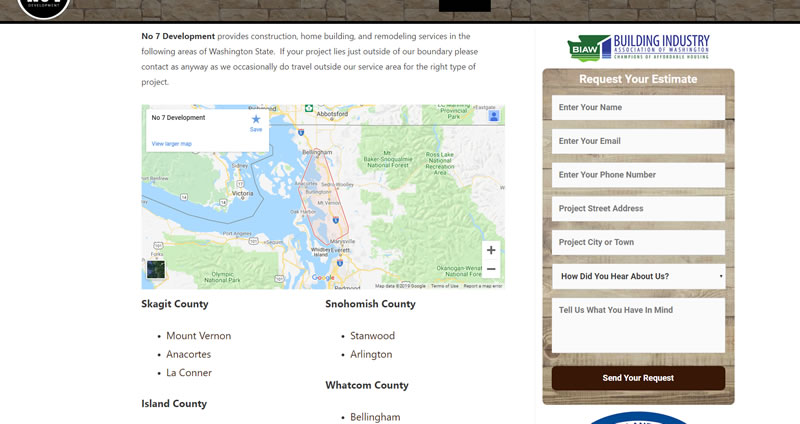
A best practice for listing covered areas is to create a page for each city, town county or state that you provide services in. This helps searchers find you when they search for your services in a particular area, and it sends a clear indication to them that you can help.
#10. It Lacks a Proper Call to Action
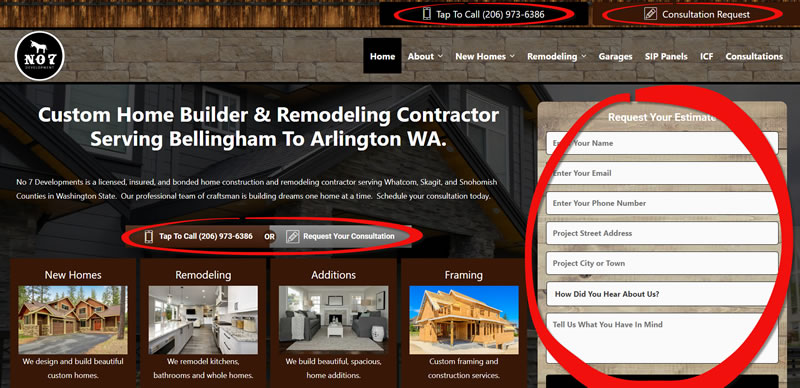
You must make it easy for your visitors to contact you through your website. You might think it’s easy for a visitor to click a little link at the top that says “contact us” or scroll down to the bottom of your website just to find your phone number and contact details, but it’s not! Your visitors are extremely fickle and if it’s not dead obvious what the next step is then many of them just won’t act.
Effective calls to action prompt your visitors to take immediate action. Ideally, you should have a phone number at the top of your website, and it should be clickable on mobile devices so people can quickly call you. Another important call to action is your contact form. Instead of just having a contact form on your “contact” page, consider placing your contact form on every page of your website.
ASK your visitors to request a consultation, or request an estimate or whatever it is you’d like them to do throughout your content and on every page of your website.
Check Your Website Now
Now that you know about these 10 mistakes and you have an idea on what you need to do it’s time to take action! Go through your own website if you currently have one and make sure you aren’t making any of these mistakes. If you’re going to build your own website or you’re hiring a developer to build one for you make sure you avoid these mistakes!
Do You Need Help With Your Construction Or Home Services Website?
Sites4Contractors specializes in building beautiful, results-generating, websites and managing digital marketing campaigns for construction companies, roofing companies, landscaping companies, painting contractors, power washing contractors, and more. If you are a construction or trades contractor of any type we can work with you.


